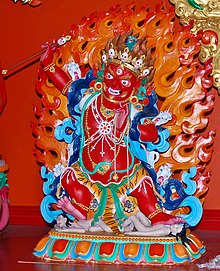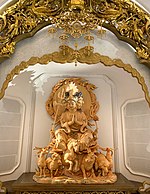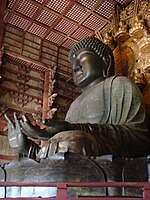Hayagriva (Buddhism)

In Chinese, Tibetan and Japanese Buddhism, Hayagrīva ("having the neck of a horse") is an important deity who originated as a yaksha attendant of Avalokiteśvara or Guanyin Bodhisattva in India.[1] Appearing in the Vedas as two separate deities, he was assimilated into the ritual worship of early Buddhism and eventually was identified as a Wisdom King in Vajrayana Buddhism.[1]
In Tibet[]
In Tibet, Hayagriva was promoted especially by Buddhist teacher Atiśa[2] and appeared as a worldly dharmapala.[1] His special ability is to cure diseases, especially skin diseases even as serious as leprosy, which is said to be caused by nāgas.[citation needed]
In Japan[]

In Japanese Mahayana Buddhism, Hayagriva is considered a form of Avalokiteśvara with wrathful form (Batō Kannon 馬頭觀音, lit. Hayagrīva-Avalokiteśvara/ Horse Head Avalokiteśvara) , one of the six Avalokiteśvaras intended to save the sentient beings of the six realms: deities (deva), demigods (asura), human beings, animals, hungry ghosts, beings of hell. Hayagriva's sphere is realm of animals (or beings whose state of mind are animal-like). In Folk religion in Japan, Hayagriva was also worshipped as the guardian deity for horses because of its name Horse-head (Batō). The horse was symbolized as a vehicle, not as one of Hayagriva's heads.
In China[]
In Chinese Buddhism, Hayagriva is known as Mǎtóu Guānyīn 馬頭觀音 (lit. Hayagrīva-Avalokiteśvara/ Horse Head Avalokiteśvara).[3] He is venerated as a guardian protector of travel and transportation, especially for cars, and is sometimes placed at the entrance and exits of temples to bless visitors.[4] In some temples, visitors are allowed to have their license plates enshrined in front of an image of this deity to invoke his protection over their vehicle.[5] He is also counted as one of the 500 Arhats, where he is known as Mǎtóu Zūnzhě 馬頭尊者 (lit. The Venerable Horse Head).[6] Similar to Japan, he is also considered to be one of the six Avalokiteśvaras intended to save the sentient beings of the six realms of Saṃsāra, with his sphere being the realm of animals (or beings whose state of mind are animal-like). He is commonly conflated with another form of Avalokiteśvara that also performs this same function in the Tiantai tradition: Amoti Avalokiteśvara (Āmótí Guānyīn 阿摩提觀音) or Lion Fearless Guanyin (Shīzǐ Wúwèi Guānyīn 獅子無畏觀音), which is considered to be one of thirty-three main incarnations of Avalokiteśvara and is often portrayed in iconography as riding on a white lion as a mount.

In Taoism, Hayagriva was syncretized and incorporated within the Taoist pantheon as the god Mǎ Wáng 馬王 (lit. Horse King), who is associated with fire. In this form, he is usually portrayed with 6 arms and a third eye on the forehead.[7]
In Chinese folk tradition, Hayagriva was sometimes assimilated into Horse-Face, one of two theriomorphic guardians of Diyu, the underworld. Some Chinese horse owners also worship Hayagriva in a non underworld form to protect their horses.
Buddhist iconography[]
In his simplest form Hayagriva is depicted with one face, two arms and two legs, and a horse head above his head. Everything about him is wrathful - a scowling face with three glaring eyes, a roaring mouth with protruding fangs, a pose of warrior’s aggressiveness, a broad belly bulging with inner energy, a sword raised threateningly in his right hand (poised to cut through delusion), his left hand raised in a threatening gesture and snake ornaments. This terrifying aspect expresses compassion’s fierce determination to help us overcome inner egotism and outer obstructions.
In other representations, Hayagriva has six hands, four or eight legs and three large eyes. in these versions, on the top of Hayagriva’s head are three small green horse heads. The legs stand on two corpses, symbolizing the mundane attachments that should be destroyed.[8]
Gallery[]

Painting of Hayagriva (Japanese: Bato Kannon). Ink, color, gold, and silver on silk. Japan, 12th century.

Shrine to Hayagriva (Chinese: Matou Guanyin) in Mount Putuo Guanyin Dharma Realm; Zhejiang, China
See also[]
References[]
| Wikimedia Commons has media related to Hayagriva. |
- ^ Jump up to: a b c Lopez 2013, p. 346.
- ^ Hugo Kreijger (2001). Tibetan Painting: The Jucker Collection. Serindia Publications, Inc. pp. 106–. ISBN 978-0-906026-56-4. Retrieved 23 June 2012.
- ^ Buswell, Robert E.; Lopez, David S., eds. (2017). "The Princeton Dictionary of Buddhism". Oxford Reference. doi:10.1093/acref/9780190681159.001.0001.
- ^ "三十三观音堂 - 快懂百科". www.baike.com. Retrieved 2021-04-17.
- ^ "车神殿牌位认捐供奉-白塔寺". www.baitasi.net. Retrieved 2021-04-17.
- ^ "110.馬頭尊者". 五百羅漢 (500Arhat) (in Chinese). 2013-09-28. Retrieved 2021-04-17.
- ^ Chinese and Tibetan esoteric Buddhism. Yael Bentor, Meir Shahar. Leiden. 2017. ISBN 978-90-04-34050-3. OCLC 967456890.CS1 maint: others (link)
- ^ Kinley Dorjee, Iconography in Buddhism, Thimphu, Bhutan: Blue Poppy, 2018, 45.
Bibliography[]
- Buswell, Robert; Lopez, Donald S. (2013). The Princeton Dictionary of Buddhism. Princeton University Press. ISBN 978-0-691-15786-3.
- Lévi, Sylvain; Takakusu, Junjir; Demiéville, Paul; Watanabe, Kaigyoku (1929). Hobogirin: Dictionnaire encyclopédique de bouddhisme d'après les sources chinoises et japonaises (Batōkannon), Paris: Maisonneuve, vols. 1–3, pp. 58–61
- Dharmapalas
- Pastoral gods
- Avalokiteśvara
- Wisdom Kings
- Vajrayana
- Herukas
- Wrathful deities




